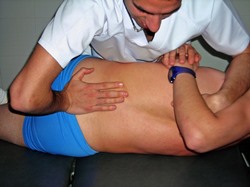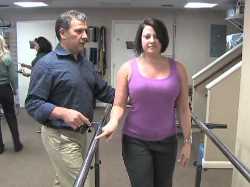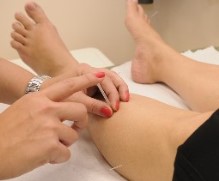How to Find the Right Physical Therapist Program near Sandia 78383
 Obtaining a physical therapist degree near Sandia TX is a critical first step to beginning a fulfilling career in the healthcare industry. Physical therapists (PT) help people who have been debilitated as a result of injury or illness regain mobility and function. But before they may legally practice and provide treatment for the rehabilitation of patients, they need to get the appropriate education and training. A PT must additionally be licensed in all states, a large number mandating that the licensee earn a physical therapy degree from an accredited school. So before selecting a physical therapy school, it’s necessary to investigate the ones you are thinking about to make sure they will provide a quality education and meet your state’s licensing criteria. What you do not want to do is choose a college simply because it happens to be the closest to your home or it has cheapest tuition. There are other significant qualifications that need to be considered besides location and cost. But before we discuss what those qualifications are and the questions you should be asking, we’ll address what a physical therapist does and what the educational options are.
Obtaining a physical therapist degree near Sandia TX is a critical first step to beginning a fulfilling career in the healthcare industry. Physical therapists (PT) help people who have been debilitated as a result of injury or illness regain mobility and function. But before they may legally practice and provide treatment for the rehabilitation of patients, they need to get the appropriate education and training. A PT must additionally be licensed in all states, a large number mandating that the licensee earn a physical therapy degree from an accredited school. So before selecting a physical therapy school, it’s necessary to investigate the ones you are thinking about to make sure they will provide a quality education and meet your state’s licensing criteria. What you do not want to do is choose a college simply because it happens to be the closest to your home or it has cheapest tuition. There are other significant qualifications that need to be considered besides location and cost. But before we discuss what those qualifications are and the questions you should be asking, we’ll address what a physical therapist does and what the educational options are.
What is a Physical Therapist’s Job Description?
 Physical therapists practice in varying settings, including Sandia TX hospitals, health clinics, rehabilitation centers, nursing homes and health clubs. What the facilities all share in common is that they have the equipment for the diagnosis and rehabilitation treatment of patients. As previously touched on, physical therapists help patients that are experiencing a lack of mobility and frequently pain due to injury or illness. After patient diagnosis, they create a program of treatment to resolve the mobility problems and lessen or eradicate any pain. They also strive to prevent any progression of the disability. Although the causes of disability necessitating physical therapy are numerous, they include:
Physical therapists practice in varying settings, including Sandia TX hospitals, health clinics, rehabilitation centers, nursing homes and health clubs. What the facilities all share in common is that they have the equipment for the diagnosis and rehabilitation treatment of patients. As previously touched on, physical therapists help patients that are experiencing a lack of mobility and frequently pain due to injury or illness. After patient diagnosis, they create a program of treatment to resolve the mobility problems and lessen or eradicate any pain. They also strive to prevent any progression of the disability. Although the causes of disability necessitating physical therapy are numerous, they include:
- Osteoporosis and Arthritis
- Motor vehicle accidents
- Strokes.
- Cardiac arrest.
- Carpal Tunnel Syndrome.
- Fire injuries.
- Knee Replacement.
- Sciatica.
- Cerebral Palsy.
Licensed physical therapists work in close partnerships with other Sandia TX health specialists, including doctors, chiropractors, registered nurses and dentists. They can also manage one or more physical therapy assistants who work under them assisting with diagnosing and treating their patients. One thing to bear in mind for anyone considering going into the physical therapy field, it is quite physically demanding. Physical therapists routinely lift patients and heavy equipment, and stand, crouch and kneel for long periods of time on a daily basis.
Physical Therapist Degrees
 There are 3 physical therapy degree options available for students to enroll in at the graduate and undergraduate levels. Of these choices, the single degree that is offered to become a physical therapist is the doctorate. Undergraduate degrees target either preparing students to become a physical therapy assistant (PTA) or prepping them to progress to the doctoral level. Below are short descriptions of degree levels that are offered in the Sandia TX area:
There are 3 physical therapy degree options available for students to enroll in at the graduate and undergraduate levels. Of these choices, the single degree that is offered to become a physical therapist is the doctorate. Undergraduate degrees target either preparing students to become a physical therapy assistant (PTA) or prepping them to progress to the doctoral level. Below are short descriptions of degree levels that are offered in the Sandia TX area:
- Associate Degrees train students to become physical therapy assistants, or can be used as a stepping stone to a more advanced degree. Applicants must have a high school diploma or equivalent to be accepted for enrollment. The degrees are usually made available by community or junior colleges, and require 2 years for completion. Clinical training, which may be in the form of an internship is normally part of the course of study.
- Bachelor’s Degrees are designed as pre-physical therapy education to prepare candidates to move up to the doctoral level. Although they are not required to be qualified for the doctoral program, they are an integral first step to becoming a PT. As with the majority of bachelor’s degrees, they generally take 4 years to complete and commonly include an internship program of a minimum of 500 hours.
- Doctorate Degrees are mandated if you want to become a licensed practicing physical therapist. The degree program must also be accredited by the Commission on Accreditation in Physical Therapy Education (CAPTE). After earning the bachelor’s degree, the doctoral takes 3 years to complete, making the total investment of time seven years in the majority of cases. Practical or clinical training is an essential element along with the extensive lab and classroom instruction. Consequently the completion of an internship is required, not solely for graduation but in several states for licensing also.
The Doctor of Physical Therapy (DPT) has replaced the Master’s of Physical Therapy (MPT), which has been phased out and is no longer available in the USA. A number of licensed physical therapists having a master’s or even a bachelor’s degree were “grandfathered” in prior to the current licensing mandate for a doctorate was instituted.
Physical Therapist Schools Online
 Although not as common as the on campus options, there are many accredited online physical therapist degrees offered, even more at the graduate level. Due to the hands-on nature of the training, internships and clinical lab work are incorporated with the online classes. This requires that the student live close to the college campus or nearby an available internship. However, the online part of the course of study can be accessed within the convenience and comfort of the student’s Sandia TX home. Online programs are not only to some extent more accessible, but in many cases more economical. Tuition may be somewhat less than comparable on campus alternatives, and expenses for commuting are minimized. And many of the online schools are accredited by the CAPTE, ensuring a quality education. These benefits can make the online option the right choice for those students that are disciplined enough to learn at home.
Although not as common as the on campus options, there are many accredited online physical therapist degrees offered, even more at the graduate level. Due to the hands-on nature of the training, internships and clinical lab work are incorporated with the online classes. This requires that the student live close to the college campus or nearby an available internship. However, the online part of the course of study can be accessed within the convenience and comfort of the student’s Sandia TX home. Online programs are not only to some extent more accessible, but in many cases more economical. Tuition may be somewhat less than comparable on campus alternatives, and expenses for commuting are minimized. And many of the online schools are accredited by the CAPTE, ensuring a quality education. These benefits can make the online option the right choice for those students that are disciplined enough to learn at home.
Questions to Ask Physical Therapist Schools
At this point you most likely have come to decision regarding several of your preliminary questions, like the type of physical therapist degree you intend to attain, where you prefer to attend classes, and how much you can afford to spend for your education. But since there are so many PT schools within the Sandia TX area and across Texas, you’ll have to look into other qualifications as well in order to further reduce your list of college options. Furthermore, you need to be sure that you enroll in the college that is right for you. That’s why we have put together a list of critical questions that you must ask the physical therapy schools you are thinking about. Ask all of the potential schools these questions before making a final selection.
Is the Physical Therapy Program Accredited? Ask if the schools you are reviewing have received accreditation from a national or a regional agency. As earlier stated, if you are pursuing a doctoral degree the program must be accredited by the Commission on Accreditation in Physical Therapy Education (CAPTE). If you select an online college, it can also obtain accreditation from the Distance Education and Training Council. It’s imperative that both the physical therapy program and school you select are accredited, not simply the school. Also, check that the accreditation is from a U.S. Department of Education acknowledged accrediting organization. In addition to ensuring that you receive a quality education, accreditation may be required for state licensing as well as for getting student loans or financial aid.
What is the College’s Ranking? In addition to accreditation, it’s imperative that the college and program you select have exceptional reputations within the physical therapy profession. There are a number of ways you can look into a PT program’s reputation, beginning with requesting references from employers that they place their graduates with. You may also search for online reviews and rating services and ask the accrediting organizations for their reviews also. Get in touch with several Sandia TX physical therapist centers or other health care facilities that you may have an interest in working for and ask if they can offer any recommendations about your college selections. It may also be prudent to contact the Texas Attorney General and school licensing authority to see if any complaints have been filed against the schools.
What is the School’s Job Placement Rate? There are a couple of important statistics that you need to know about each of the physical therapy schools you are reviewing. One is their graduation rate. A low rate might indicate that students left because of displeasure with the program, the teachers, or both. Once the students have graduated, how many of them are being placed in jobs with the support of the college’s job placement program, particularly in the Sandia TX area? If a college has a higher job placement rate, it suggests that its reputation within the health care field is good or even exceptional. It also confirms that the college has a large network of contacts to help students get internships or jobs upon graduation.
Does the School Prepare You For Licensing Requirements? It’s imperative that the college you choose furnishes both superior training and a course of study that satisfies the licensing criteria for Texas or the state where you will be working. In each state a passing score is required on the National Physical Therapy Examination (NPTE) along with a degree from an accredited physical therapist college. Although licensing requirements fluctuate state by state for PTA and PT graduates, many states require a minimum amount of clinical hours be performed and passing scores on additional tests.
Are Internship Programs Offered? Ask if the physical therapist colleges you are assessing have partnerships with Sandia TX hospitals or clinics for internship programs. Not only are internships an excellent manner to get hands on experience in a clinical environment, they are also a requirement for the majority of PT programs and state licensing. As a secondary benefit, they can assist graduates and students establish professional relationships in the Sandia medical community and assist with job placement after licensing.
How Large are the Classes ? Unless you are the type of person that prefers to sit way in the back of class or get lost in the crowd, you will undoubtedly want a smaller class size. Smaller classes enable more individual participation and one-on-one instruction. Ask the physical therapist schools you are looking at what the average student to teacher ratio is for their classes. If practical you may want to sit in on one or more classes before making your final determination. This will also give you a chance to converse with some of the students and instructors to get their opinions regarding the pharmacist technician program also.
Where is the Program Located? For a number of students, the physical therapist college they select will need to be within commuting distance of their Sandia TX residence. Students who have decided to attend classes online naturally will not have to concern themselves with the location of the campus. However, the availability of area internships will be of importance. Something to bear in mind is that if you decide to enroll in a school that is out of state or perhaps out of your local area, you may need to pay a higher tuition. State colleges commonly charge higher tuitions for out of state residents. And community colleges typically charge a higher tuition for those students that live outside of their districts.
Is Financial Help Offered? The majority of DPT schools offer some form of financial aid to their prospective students. Ask if the colleges you are examining have a financial assistance office and see what kind of assistance is available. At a minimum they should help in getting a student loan or any scholarships you might qualify for. A number of physical therapist colleges provide scholarships, while others provide work programs. So before you eliminate a college because the tuition is too expensive, find out what financial assistance may be available.
Can the Program Accommodate your Schedule? And last you must verify that the physical therapy college you ultimately select can furnish the class schedule you need. This is particularly essential if you choose to continue working while attending school. If you need to schedule evening or weekend classes in the Sandia TX area, confirm that they are available. If you can only attend part-time, find out if that is an option and how many credit hours or courses you would have to enroll in. Also, ask what the procedure is for making up any classes that you might miss as a result of work, illness or family obligations.
Earning Your Physical Therapy Degree near Sandia Texas?
If you are planning on attending a Physical Therapy School in the Sandia TX area, the following information may prove to be both interesting and educational regarding the location of your future Alma Mater.
Sandia, Texas
Sandia was in the Casa Blanca land grant, issued to Juan José de la Garza Montemayor by Spain on April 2, 1807. The Montemayor family occupied the land until 1852. In 1896 John L. Wade purchased it and established the Casa Blanca Ranch (Wade Ranch). Upon his death the ranch was divided among his heirs, one of whom sold his share to Joseph B. Dibrell. Dibrell gave the task of dividing and selling the land to Fennell Dibrell and Max Starcke, who founded Sandia in 1907. At the time the streets were platted there was only one building in the community. Dibrell and Starcke chose the name Sandia, Spanish for "watermelon," because of the large number of watermelons grown in the area. The lots in Sandia were all sold within eight months, during which time a lumberyard, a hardware store, two grocery stores, a meat market, a boardinghouse, and a barbershop opened. By 1914 Sandia had 150 inhabitants, a bank, two general stores, and a cotton gin. The population steadily increased and in 1925 was estimated at 200. It had increased to 500 by 1927. In 1936 Sandia had three businesses, two churches, multiple farm units, and several dwellings and was a stop on the Texas and New Orleans Railroad. In 1940 it had a population of 300 and fifteen businesses. Sandia had a peak population of 310 during the 1960s and early 1970s. Residents numbered 215 in 1974 and 1990.
As of the census[1] of 2000, there were 431 people, 139 households, and 106 families residing in the CDP. The population density was 445.3 people per square mile (171.6/km²). There were 158 housing units at an average density of 163.2/sq mi (62.9/km²). The racial makeup of the CDP was 75.87% White, 1.16% African American, 3.25% Native American, 0.93% Asian, 0.23% Pacific Islander, 16.47% from other races, and 2.09% from two or more races. Hispanic or Latino of any race were 61.25% of the population.
There were 139 households out of which 35.3% had children under the age of 18 living with them, 61.2% were married couples living together, 9.4% had a female householder with no husband present, and 23.7% were non-families. 22.3% of all households were made up of individuals and 7.9% had someone living alone who was 65 years of age or older. The average household size was 3.10 and the average family size was 3.63.
Select the Ideal Physical Therapist School near Sandia TX
Selecting the ideal physical therapist program is a necessary first decision you must make to start a rewarding career in the health care field. As we have discussed in this article, the PT or DPT degree program and college you select should both have outstanding reputations and accreditation. However there are additional relevant questions that you should ask pertaining to your college of choice as well. As you begin your search for a physical therapy program, bear in mind that a number of factors will guide you toward your ultimate decision. You may want to visit each of the campuses to view their facilities and talk with current DPT students. While there, ask yourself this critical question: will this program help me accomplish my goal of becoming a licensed practicing physical therapist? By adhering to our list of additional questions, you will have the ability to narrow down the options so you can make the right choice. And with the proper education and training, you can accomplish your dream to become a practicing physical therapist in Sandia TX.
A Few More Interesting Locations in Texas



